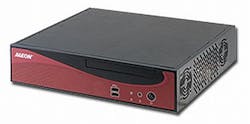Embedded servers for IP surveillance and factory automation introduced by AAEON
TAIPEI, Taiwan, 3 Jan. 2013. AAEON in Taipei, Taiwan, is introducing two embedded servers -- the AIS-E1 and AIS-E2 -- for IP surveillance, factory automation, building automation, advanced digital signage and kiosks.
Designed with upgradable socket type multi-core Intel Core iSeries processors under 45 Watts, these embedded computing servers offer performance and multiple high-definition video playbacks, while consuming very little power, AAEON officials say.
The AIS-E1 embedded server supports 2nd Generation Intel Core i7/ i5/ Celeron processors, with a built in Intel QM67 chipset and supports two 204-pin dual-channel DDR3 1066/1333/1600 MHz SODIMM, as much as 16 gigabytes.
The embedded server connects to six USB 2.0 ports, dual displays via VGA, LVDS, as well as DVI-D, HDMI supporting HD dual display, two Gigabit Ethernet, one COM port (expandable to six), three audio ports, and two KB/MS ports.
The AIS-E1 offers four 2.5-inch hard drives or solid-state drives, supports RAID 0, 1, 5, 10, plus one onboard CFast SSD and one Slim ODD bay. Optional wireless features can be added via a PCI Express 3.0 mini-Card slot that supports 802.11b/g/n and Bluetooth 3.0. With 12-volt DC-in and measuring 315 by 70 by 300 millimeters
The AIS-E2 embedded server is an upgraded version of AIS-E1, built to be more compact, measuring 195 by 70 by 220 millimeters. The AIS-E2 supports 3rd Generation Intel Core i7/ i5/ Celeron processors, with built in Intel QM77 chipset and supports two 204-pin dual-channel DDR3 1066/1333/1600 MHz SODIMM, as much as 16 gigabytes.
Most of the connectivity remains the same as the AIS-E1 model, except for four faster 5-gigabit-per-second USB 3.0 ports, one additional Display Port and supports a maximum of two 2.5-inch hard drive or solid-state drive.
For more information contact AAEON online at www.aaeon.com.

